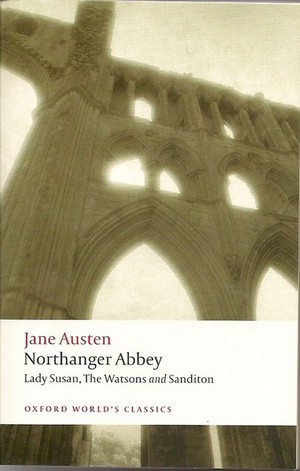Ellen and Jim Have a Blog, Too
We are two part-time academics. Ellen teaches in the English department and Jim in the IT program at George Mason University.


A Journey through Austen's career: the latest Oxford _Northanger Abbey_, _Lady Susan_, _The Watsons_ and _Sanditon_ · 21 October 08
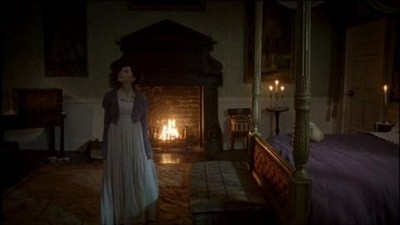
Catherine (Felicity Jones) gazes round her room at Northanger (from the 2007 Granada/WBGH NA)
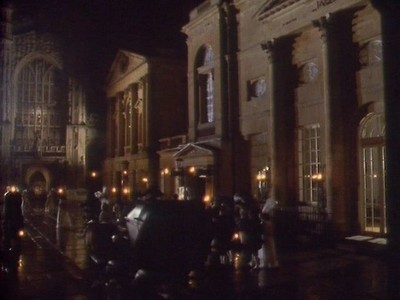
The pump room and Abbey at Bath (from the 1987 BBC NA)
If you buy any of this reissue of the Oxford editions of Austen, buy this. It alone makes available three precious texts by Austen not in print for a reasonable price anywhere else. No other recent edition of Austen’s writing does this1.
Gentle friends,
Here Laurel and I are for the fifth of our six diptych reviews of the 2008 reissue of the 2003 Oxford editions of Austen’s novels2. I hope I haven’t surprized anyone when I urged this volume more than any other of the series as a “must-buy,” but if I have, here’s why.
In one inexpensive annotated volume we have four novels by Jane Austen, three of which are today hard to find in such a format: Lady Susan & The Watsons first published in 1871, and Sanditon, first published in 1925 (!) are today only readily available otherwise in Chapman’s Minor Works, Volume VI (1954: rpt. with revisions London: Oxford UP, 1969), last printed in 1988 in hardcover. Its classical scholarly apparatus intimidates, and it lacks explanatory notes meant for the common reader
The original new Oxford set established by James Kinsley in 1971 followed a tradition stemming from the first posthumous publication of Northanger Abbey in 1818: Kinsley included Northanger Abbey and Persuasion in one volume3, but as of 19804, Oxford printed Northanger Abbey with Lady Susan, The Watsons and Sanditon. Thus in one accessible volume the buyer obtains:
Northanger Abbey, a novel first drafted 1793-94, written 1798-99, whose revisions (1803 as Susan and 1816 as Catherine) make it at once a palimpsest of Austen’s earliest work and interests, and a text which includes her latest and most sophisticatedly charming writing5;
Lady Susan, a brilliant sexually-frank epistolary novel, the only one of Austen’s to focus on an amoral adulterous heroine, probably first written in 1793-94, around the time Austen is said to have written the first version of Sense and Sensibility, the epistolary Elinor and Marianne, and rewritten between 1804-5 (possibly once again in 1808-9);
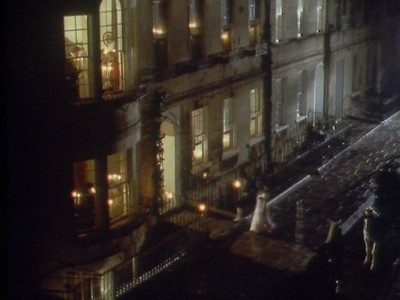
Lady Susan takes place partly in Bath; 30 years before The Watsons opened Emma Watson’s aunt danced, a fine woman then, in the “old rooms” at Bath with Mr Edwards (the lower rooms, from the 87 NA);
The Watsons, first written and worked hard on from 1804 to 1807, and while still a fragment, a thoroughly-worked or imagined gem which reads as richly and deeply as any of Austen’s finished novels, the only one of her works first written while in Bath and thus reflecting her something of her perspective while there; like Lady Susan, uncensored (as it never was written up for publication) it anticipates Mansfield Park:

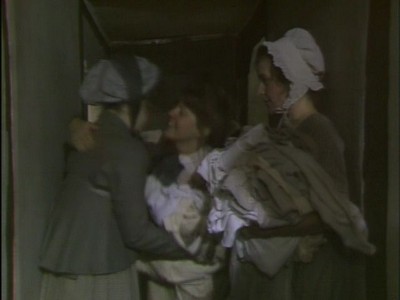
These scenes of Fanny’s arrival in Portsmouth (Sylvestre Le Tousel, Eryl Maynard, Alison Fisk, as Fanny, her sister and mother, from the 1983 BBC Mansfield Park) could be shots from a film of The Watsons as Emma Watson arrives and is greeted by her sister with an ailing father upstairs;
Sanditon, her very last (1817) stunningly effective early draft of a novel, astonishingly filled with black humor about traumatic illnesses and death (Austen was herself mortally ill and had to put it down as she was dying), a work which is set uniquely in a contemporary unscrupulously commercialized seashore.
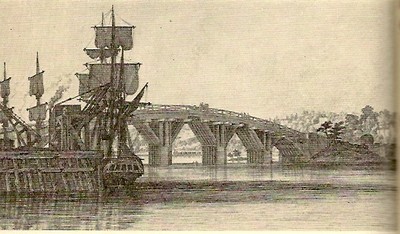
Northern Bridge, Itchen (not far from Austen’s house in Southampton), later 18th century. A military encampment.
Thus the reader may travel through Austen’s writing career, from 1793 to 1817, in 340 pages.
************
So, for a fifth time, here is Laurel’s blog-posting:
“And what are you reading, Miss — ?” “Oh! It is only a novel!” replies the young lady, while she lays down her book with affected indifference, or momentary shame. “It is only Cecilia, or Camilla, or Belinda”; or, in short, only some work in which the greatest powers of the mind are displayed, in which the most thorough knowledge of human nature, the happiest delineation of its varieties, the liveliest effusions of wit and humour, are conveyed to the world in the best–chosen language.” The Narrator, Chapter 5
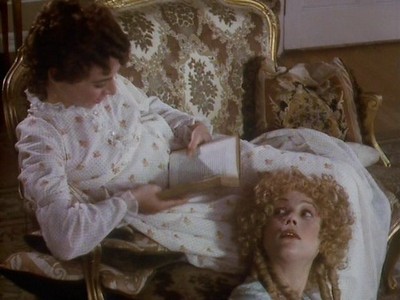
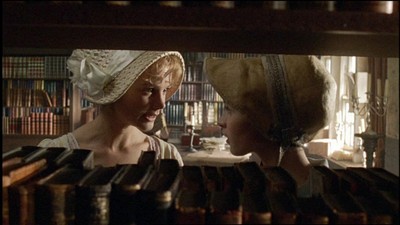
Relishing and revelling in their women’s books (Katherine Schleisinger and Cassie Stuart; Felicity Jones and Carey Mulligan, as Catherine and Isabella in a circulating library in 87 and 07 NAs)
Jane Austen’s Northanger Abbey is the novel that almost wasn’t. We know from Cassandra Austen’s notes that her sister Jane wrote it during 1798-1799, prepared it for publication in 1803, and sold it to publishers Crosby & Company of London only to never see it in print. It languished on the publisher’s shelf for six years until Austen, as perplexed as any authoress who was paid for a manuscript, saw it not published, and then made an ironical inquiry, supposing that by some “extraordinary circumstance” that it had been carelessly lost, offering a replacement. In reply, the publisher claimed no obligation to publish it and sarcastically offered it back if repaid his 10 pounds.
Seven more years pass during which Pride and Prejudice is published in 1813 to much acclaim, followed by Mansfield Park in 1814 and Emma in 1815, all anonymously ‘by a lady’. With the help of her brother Henry, Austen then buys back the manuscript from Crosby & Company for the same sum, for Crosby could not know this manuscript was written by a now successfully published and respected author and thus worth quite a bit more. Ha! Imagine the manuscript that would later be titled Northanger Abbey and published posthumously in 1818 might never have been available to us today. If its precarious publishing history suggests it lacks merit, I remind readers that ironically in the early 1800’s most viewed it as “only a novel”, whose premise its author and narrator in turn heartily defend…
**************
And here’s mine:
On the new Oxford edition itself: while I agree with Laurel, that Claudia Johnson’s essay is accessible and lively, the part dedicated to the three shorter works is flawed. In the 20 pages devoted to discussing Northanger Abbey itself, she takes the recent (and accurate perspective) that far from simply mocking the gothic and replacing it with diurnal reality, whether you regard this as potentially cruel, mean, and risky (especially in the case of General Tilney), or a light account of a young girl’s entrance into real life, Austen recreates the gothic conventions to make an emotionally effective and sensitively felt novel of female development, one which is also an instance of affirmative and psychologically acute female gothic romance6. The chosen cover to the book rightly evokes a ruined abbey:
We have three young heroines who know considerable grief and one absent one, now dead (Mrs Tilney) whose life was, we are told, very hard.
By contrast, though, Johnson’s 7 and 1/3 pages devoted to Lady Susan, The Watsons, and Sanditon (and most of these to Sanditon) read like an afterthought. Johnson presents Lady Susan (2 pages) as an early work! She appears not to know or does not mention the recent and numerous studies which date it much later; she does not bring in its actual literary predecessors (e.g., Choderlos de LaClos’s Les Liaisons Dangereuses) and blithely ignores the real anguish in the book: Lady Susan bullies and terrifies her daughter; this novel is not a shallow caricatured sketch. It may not have been published because Austen’s family could not allow her to show herself so casually cognizant of adultery7.
Johnson’s two pages on The Watsons reveal more readerly knowledge of Austen’s text. She writes eloquently:
“It is unquestionably Austen’s bleakest work, taking on such painful subjects as the care of ageing parents, the shame and desolation of downward social mobility, and the mortifications of familial alienation. Raised in conditions of wealth and refinement under the patronage of a loving aunt [who has married unwisely and given herself a tyrant husband], Emma Watson must return home … [her] family isso impoverished that it borders on the ungenteel; her invalid father is querulous; her sisters are unrefined [desperate, voracious, treacherous]; and her brother, who sees sisters as costs, is high-handed and indelicate about her reappearance” (xxix).
Johnson, though, misleads by repeating as unqualified truth theories from the family about why she didn’t finish it, particularly those which imply Austen didn’t like what she had done. The characters in The Watsons are fully-formed and of real interest; one can foresee what will be the intense psychological development and how Austen drew her story regularly from such textures (so by studying this book you study Austen’s technique). Although much resembles in outward outline parts of Austen’s other novels, they are transpositions into another key, individualized so that we are in different presences once again and can study Austen’s underlying geology at the same time. Austen had apparently worked out her ending, and the piece contains a few of her most moving scenes, and a rare one where a woman rescues a young boy at an assembly from mortification8.
People seem to want to forget Austen died young. She first secured a stable place to live from which to publish in 1809; she was dead by 1817 and inbetween she published 4 books and worked up semi-finished versions of 2 more. She may have intended to come back to The Watsons; it was not as far along as the others, begun later. Henry tells us in his invaluable preface to Northanger Abbey (unfortunately not reprinted in this new Oxford) that “some of her [published] novels” were “the gradual performances” of her “previous life” (i.e., when she lived in Steventon and Bath); there’s no reason to think she would treat The Watsons any differently. She would put it away and take it out again, revise, and then again put it away, until she felt it was time to revise again.
Henry writes:
“For though in composition she was equally rapid and correct, yet an invincible distrust of her own judgement induced her to withhold her works from the public, till time and many perusals had satisfied her.”
Kathryn Sutherland has now demonstrated from the manuscripts the extraordinary quality of her books comes from endless revisions9.
For Sanditon (3 and 1/3 pages) Johnson repeats Southam’s argument that it is the most finished of the fragments, which (among others) Sutherland shows just won’t stand up to scrutiny; what we have here is a revealing early draft, startling in its feel of rapidity and wild brilliance of invention.
I recommend supplementing Johnson’s introduction: the wise thing to do is find (if the reader can) a used copy of Margaret Drabble’s edition of these works, especially for Sanditon and read her introduction (sensitive, accurate, insightful throughout): Drabble includes a second preface on social background (helpful for The Watsons and Sanditon) what is so astonishing and refreshing in this rich fragment:
“What we have here, in fact, is a dying woman treating the subject of illness with amusement and raillery .. the whole tone of the novel is very different from that of its immediate predecessor, Persuasion ... the chief focus … is on Sanditon itself, and the spirit of change it represents .. the chief target of her satire [being] speculation, expansion, change and novelty.”
There is a romance brewing, a dangerous one: the impoverished young cousin, Clara Brereton, taken in by the rich domineering, Lady Denham, has apparently been seduced into a risky relationship with a young dense and amoral young man, Sir Edward Denham, whose admiration for Richardson’s Lovelace, tells us what he intends for Clara. Another love relationship adumbrated is between the book’s apparent heroine, Charlotte Heywood, and a young man expected home, a genial and respected son and brother to the members of the Parker family who dominate the text as we have it10.
***************
We cannot ignore textual problems—as three of these books were never printed in Austen’s lifetime and one printed after her death. All were titled by other people.
The circumstances of the chosen text of the edition’s Northanger Abbey resembles that for Pride and Prejudice, Mansfield Park and Emma. Since there was only one edition in Austen’s lifetime, the first printed edition is our sole authority. It’s a problematic one since it was not Austen herself who wrote out or supervised and proofed the final fair copy of Northanger Abbey. Kinsley followed Chapman’s “normalizing” principles and texts: Austen unchapmaned. There is a clean fair copy of Lady Susan, and differently amended (showing corrections and different considered choices) copies of The Watsons and Sanditon (both lack paragraphing), mostly in Austen’s hand. Davie has a brief note where he says he has has modified the Chapman approach towards the manuscripts in order to make visible Austen’s “intentions” when it comes to “substance”; however, no textual notes are provided11.
***************
Well, says the reader, why did they not become better known? Why have they remained relatively obscure? Why has no movie been made of at least The Watsons?
As Laurel says, Northanger Abbey shows up in sales charts as the least widely-sold of Austen’s novels. When I checked at Library Thing where about 29,430,000 people catalogue their books (I’m rounding off the figures), I discovered (again in round figures), about 20,750 people had at least one copy of P&P, 10,000 had a copy of Emma; 9,400, one copy at least of S&S; 7,100 one of Persuasion, 5,800 one of Mansfield Park and 4900 one of Northanger Abbey(see precise figures in review of P&P. Penguin did not keep the Drabble edition of Lady Susan, The Watsons, and Sanditon in print, and Oxford has not kept Doody’s edition of the juvenilia in print.
Basically, the three shorter books have been underestimated, ignored, and misleadingly described. The dual character of Northanger Abbey as a realistic and gothic book is often misread because it is still the case female gothic and novels of female development (especially that of a sexually innocent young women) female gothic are treated as an embarrassment.
To alter this in our present backlash era is an uphill fight. Certainly women should not begin to erase feminist and woman-centered perspectives in what they write—if you fear ridicule or non-publication, erasure only further diminishes the numbers of women in print and journalism (in mainstream publications a tiny percentage compared to men). It doesn’t help to make covers from portraits of nubile upper class young women which signalled at the time “wealth,” and now obsolete (foolish) feminine romance12.
Fortunately, the custom of putting pictures of Bath or abbeys and the picturesque on the covers of Northanger Abbey seems to be holding its own, e.g. Elisabeth Mahoney’s Everyman edition of NA alone. Mahoney rivals Butler’s Penguin editions and partly supercedes them by her coverage of non-gothic texts and her reading of the novel not as conservative but progressive and protofeminist13. Mahoney’s cover alludes to the work of dreams and romance beyond the gothic while keeping before the reader the picturesque (an important matter in NA, think or see of Catherine, Henry and Eleanor’s long conversation on Beechen Cliff at the close of Volume 1):
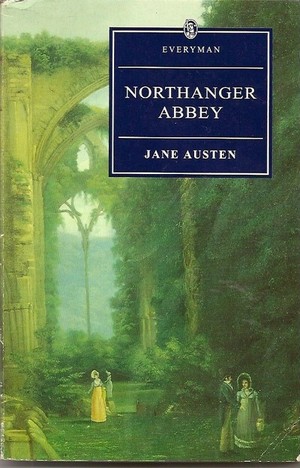
Among the excellent editions of NA which do justice to the book as a novel of female growing up and reading (explains them, shows as you read along how what books in NA enrich the book), I recommend Longman cultural edition, and the Norton edited by Susan Fraiman14,with an appropriate cover:
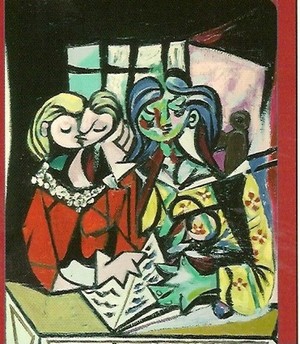
Two Girls Reading by Pablo Picasso (2004)—it’s a novel about reading
And it’s a novel about Bath. While Chawton and Steventon must take precedence in understanding the formation of Austen’s character and how she was enabled to write, Bath’s centrality in Austen’s adult life comes out strongly in an book which includes NA, Lady Susan and The Watsons.
But I need not go into Bath. Beyond the many books on Bath and Austen and Bath, I recommend Ms Place’s three blogs on Bath as just the sort of thing a reader should peruse (with pleasure) to learn about The lower assembly rooms and Bath Society; The Pump Room; and Regency Bath, to which I can add my own “In search of 18th century Bath”. Click for much information and lovely illustrations. Nowadays we need no longer depend on publisher’s for our context in reading a book. We can go to the superb blogs and websites on the Net centering on Jane Austen.
The female gothic, the picturesque, two girls reading, Bath: I am led into my final topic: the 3 marvelous movies. Fewer than the other Austen books have had, but all three (as I have written) on Jane Austen’s World:
enrich our experience of Austen’s novel. Beguiled by Austen’s parody of Ann Radcliffe’s 1790s gothic romances and allusion to the imprisoned dying bleeding nun of Matthew Lewis’s 1796 horror gothic, The Monk, all three gothicize Austen’s book. The beauty of the 87 and 07 Northanger films lie in their visual recreation of female gothic dreams. The 87 film is beautifully picturesque, and filled with thoughtful conversations taken from Austen’s book. Very like Amy Heckerling’s Clueless (the 1995 free adaptation of Emma, starring and narrated by Alice Silverstone as Cher Horowitz), Ruby in Paradise is an updated “young lady’s entrance into world:” Ruby dramatizes a teenage heroine’s struggle to discover what is and to make a good place for herself in world that can put her at serious risk. The core of the appeal of the 07 film is the capital way the two principals, Felicity Jones and J. J. Feild, jell as a pair of characters whose mutual kindness, intelligence, and integrity of heart emerges gradually as very precious indeed against the film’s “crimes of heart.”
I refer the reader over to Jane Austen Today also where the same review-essay with many lovely stills from the films appears.
For myself I’ve loved Northanger Abbey since I read it between the ages of 17 and 19. I like serious and grave books which is what Mansfield Park and The Watsons are both. I can perhaps best account for my love of NA by my love for Radcliffe (wherein I have Henry Tilney as a model) which I read around age 19 —around the same time I first encountered Fanny Burney in her diaries. I’ve read The Mysteries of Udolpho at least three times through in English, once half-way through in French15, and love reading sympathetic critical studies of the gothic where it is a central text. Laurel has asked me to write a blog about The Mysteries of Udolpho for her, and I have agreed.
I own 11 copies of Northanger Abbey, some printed by itself, a couple with Persuasion and two of the Oxfords printed with Lady Susan, The Watsons and Sanditon, one excellent Italian translation and two French, one of which is often said to be the best translation of Austen into a European foreign language we have: Catherine Morland by Felix Fenelon16. I’ve 4 copies of The Watsons and 5 of Sanditon because beyond the 2 Oxford editions and Drabble’s Penguin, I’ve a copy of Chapman’s Minor Works (valuable for the notes and annotations), and the reprint of Sanditon for Chiron Press, transcribed, edited and with an introduction by Mary Gaither Marshall, with Anne Austen Lefroy’s continuation, the very best scholarly edition of Sanditon in print17.
Interested readers may read the story of a reading and discussion of Austen’s Northanger Abbey (on Austen-l and Janeites) and Radcliffe’s Romance of the Forest (on Eighteenth-Century Worlds at Yahoo) in the context of the gothic and ecriture-femme on my website.
Next up: Persuasion and (perhaps I’ll try a blog on) The Mysteries of Udolpho
***************
Notes
1 Alas, the superlative Penguin 1974 edition of Lady Susan/The Watsons/Sandition, edited, introduced and annotated by Margaret Drabble is no longer in print, and hard to find used. Who would re-sell it? who would throw it out?
2 See Sense and Sensibility, Pride and Prejudice, Mansfield Park, and Emma.
3 David Gilson is on record wondering why in 1970-71 Oxford University Press “unaccountably chose to include Jane Austen’s novels in the Oxford English Novels series,” as obviously there were other presses producing editions, some with full apparatus, especially as this set really just reproduced Chapman’s edition with emendations; see David Gilson’s “Jane Austen’s texts: A Survey of Editions,” The Review of English Studies, new series, 53:209 (2002):84. Obviously in 1970-1, Oxford meant to update Chapman by its new introductions and notes—as well as sell new books to a younger different audience.
4 Oxford also chose to publish a freshly edited and brilliantly introduced edition of Austen’s satiric juvenilia and earliest (unfinished) novel, Catherine, or the Bower (1993, edd. Margaret Anne Doody and Douglas Murray). It has not been reprinted.
5 Northanger Abbey is the title given this novel by Henry and Cassandra Austen.
6 It should be noted that Johnson has erased all apparent feminism from her essay, the first version and overtly feminist version of which may be found in her Jane Austen: Women, Politics, and the Novel (Chicago: University of Chicago Press, 1988):28-48. An earlier and reductive attitude towards the book, one which dismisses it as light and “early” is found in the the previous introductions to this Oxford set of texts. In 1975 Kinsley’s NA/Persuasion was reprinted with an introduction by John Davie (the actual editor of the present 2003/8 texts of the shorter works); and in 1980 with an introduction by Terry Castle.
As Laurel says the gothic was regarded as “low brow reading” and “shunned” by the (mostly male) critical establishment. Castle seems not to have read Ann Radcliffe’s Mysteries of Udolpho carefully as yet (while she is the editor of the Oxford 1998 edition of Udolpho, her analysis here is made up of cliches) or has not begun to break out out the anti-gothic cant of much of the 20th century. Castle brings to bear on NA Margaret Kirkham’s feminist study and tries to align the book with the distrustful attitudes towards imaginative romances found in Mary Wollstonecraft’s Vindication of the Rights of Woman.
The editor of the text, and introducer of the 1975 Oxford, J. Davie reveals the dismissive way the book was regarded before feminist approaches made this novel of young female development socially acceptable to praise as such; the cover illustration is of an (rather old-looking) John Thorpe refusing to set Miss Morland down when she discovers he has lied to her (notice Henry and Eleanor Tilney looking back in a distanced sidewalk):
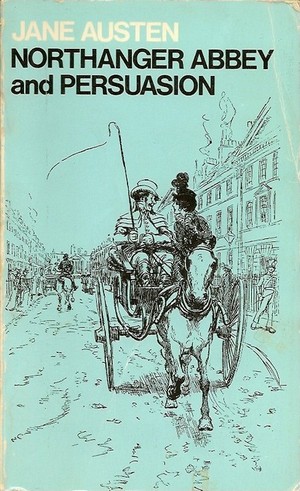
Hugh Thompson illustration, from 1921 NA edition
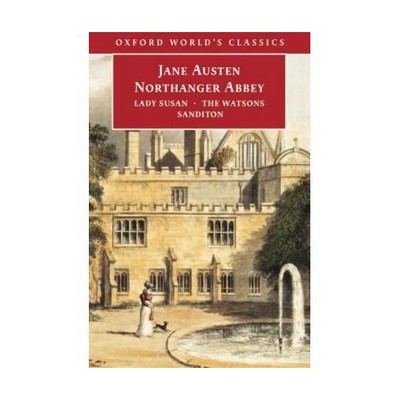
The cover for the 2003 edition introduced by Claudia Johnson. The Abbey has made its appearance, but it is not yet a gothic abbey.
7 One of the finest (short) essays on Lady Susan is in Margaret Drabble’s “Introduction” to the 1974 Penguin LS/W/S, pp. 8-15. See also Patricia Meyer Spacks’s “Female Resources: Epistles, Plots, and Power, Writing the Female Voice: Essay on Epistolary Literature, edd. Elizbeth Goldsmith (Bosonton: Northeastern University Press, 1989), 63-76; & Deborah Kaplan on both Lady Susan and The Watsons as “middle fictions,” in Jane Austen Among Women (Baltimore: Johns Hopkins, 1992):158-81; Marilyn Butler, “Simplicity,” London Review of Books 20:5 (1998):3-6.
8 Much of Persuasions 8 (1996), see pp. 61-108, is dedicated to insightful, informative and sympathetic essays on The Watsons; here I recommend particularly McMaster, Juliet, ”’God Gave Us Our Relations’: The Watson Family,” Judith Terry, ”’Knit Your Own Soul’; or, Finishing Off Jane Austen,” James Heldman, “Where Is Jane Austen in The Watsons, John Norris, “Sam Is Only a Surgeon, you know,” Mary Margaret Benson, “Excellently Qualified to Shine at a Round Game,” Joseph Wiesenfarth”The Watsons as Pretext.”
9 Kathryn Sutherland, Jane Austen’s Textual Lives: from Aeschylus to Hollywood (NY: Oxford UP, 2005):55-198. See also Brian Southam’s Jane Austen’s Literary Manuscripts: A Study of the Novelist’s development through the surviving papers (Oxford: Clarendon Press, 1964). Another flaw in this edition is the publisher has not reprinted Henry’s preface. That was customary until recently and the older and New Penguins (ed., introd, Marilyn Butler, 1995, 2003). In addition Butler’s notes are incomparably better than Johnson’s; Butler has a thorough knowledge of Radcliffe and provides parallel passages from three of Radcliffe’s novels (Sicilian Romance, Romance of the Forest, and Mysteries of Udolpho).
10 For 20 very good essays on Sanditon, see Persuasions, 9 (1997): 60-243.
11 Drabble’s 1974 Penguin text is more in line with Chapman; she wanted to make a readable accessible text. She worries she has perhaps “altered the text too much for some purists. I can only refer them back to Chapman” (39).
12 Just as bad are the continuations of Sanditon and The Watsons, two of which do not differentiate between the poorer weak text masquerading as an effective novel, e.g., Sanditon by Jane Ausen and another lady [Maria Dobbs] (NY: Signet, 1975); The Watsons by Jane Austen, concluded by L. Oulton (NY: Appleton, 1923).
13 Jane Austen, Northanger Abbey, ed., introd. Elisabeth Mahoney (NY: Everyman, 1994); also superlative for its concise introduction (once again) is Margaret Drabble’s Signet Northanger Abbey (NY: Signet, 2008); the edition is marred by a postscript by Stephanie Laurens which is actually wrong. Laurens thinks 18th century gothic novels are the same as 19th century sensational ones (she knows nothing of Radcliffe), and uses undergraduate school strictures about “telling” rather than “showing” to explain Austen’s success in a book where the narrator’s presence dominates the text.
14 This Norton edition (2004) is the superior one of the full appartus type. Fraiman includes relevant contemporary documents (other women’s novels alluded to in NA), letters, reviews, and the best recent essays about the novel and the gothic, its revisions, its themes. Also recommended is Marilyn Gaull’s Longman Northanger Abbey (2005), for its full panoply of documents and texts about Bath and of the gothic (as well as revealing illustrations).
15 I once started a project where I intended to compare Madame de Chastenay’s translation with Radcliffe’s text, but found that there were already studies of the French text and that the kind of original research needed beyond my pocketbook (travel time, expense) and connections. But I recommend the French translation as well as Chastenay’s own memoir: see Madame de Chasteny, Mémoires : 1771-1815, as published by Alphone Roserot, facsimile of 1896 edition (Elibron: 2003); Ann Radcliffe, Les Mysteres d’Udolphe, trans. Victorine de Chastenay. Paris: Gallimard, 2001
16 Felix Fenelon’s book was reprinted by Gallimard in 1946; Josette Salesse-Lavergne has translated Northanger Abbey into French in the “Domaine etranger” series (Paris: Christian Bourgeois, 1980); Italia Castellini into Italian as L’Avvazia di Northanger in Jane Austen: Tutti e romanzi, ed. Ornella de Zordo (Rome: Grandi Tascabili Economici Newton 1997).
17 Where the differentiation is clear and a study of made of Sanditon in contrast to the continuation, the edition is actually extra valuable, e.g., Jane Austen’s Sanditon: A continuation by her niece” together with Reminiscences of Aunt Jane by Anna Austen Lefroy (Chicago: Chrron Press, 1983). I own but 11 of P&P: my favorite of the Austen novels is S&S and I have 14 copies of it; my second favorite Austen novel is MP and I have 11 of that. Emma may be my least loved Austen novel; I have a hard time (as I wrote) adjusting to this heroine, and there I have 10 copies. I have not counted my Persuasion copies as I’ve not written a dyptich review with Laurel as yet.
.
--
Posted by: Ellen
* * *
Comment
- Brava!
— T. Wood Oct 22, 8:30pm # - From Clare:
“Thanks for the link to the review, Ellen. I loved the way you nailed your flag to the mast in your first sentence. After all what one wants to primarily know in a book review is if the book is worth spending one’s hard-earned cash on it.
The pictures alone are worth the time. I was interested to see, in a footnote, your high regard of the Penguin Sanditon, the edition I own, found in a long-since closed second-hand bookshop.
Clare”
— Elinor Oct 24, 3:39pm # - Dear Clare,
You’re absolutely right about getting to the point: the problem was in all the other cases, there was no clear-cut reason to recommend Oxford reissue edition above all others. Two were reasonable buys (the P&P and MP, mostly due to the introductory essays and appendices), but I couldn’t say that the Penguin or another half-way house edition wasn’t as good. So I set them in the context of other editions and did say at some point which one of the minimal apparatus and full apparatus types seemed the best for this or that reason. Margaret Drabble’s essays are superb. This makes the older Signets valuable—- the new ones have afterwards by romance writers, one of which (for P&P) I found unconsciously funny in her complaints, and the other (for NA) grossly ignorant about even what is a gothic novel. Drabble’s edition of the three short novels/fragments remains the best, but not only is it out of print, it’s very hard to find used.
It is just the texts though, for Johnson’s introductions to the short novels are weak and she offers misleading or wrong information. Probably she thinks that the popular mass reader may buy the book for NA, but why should they? There are other better editions of NA—Johnson’s introduction is good but her point of view is found in the Norton and Elisabeth Mahoney’s Everyman.
The proliferation of these novels into various editions makes for oddities because publishers are not targeting a specific audience. Who is this Oxford edition intended for? The New Penguins seem to me to offer something new as two of them print a text not usually printed and the others stick much closer to Austen’s than has been done since Chapman laid out his classical-scholarship principles So they offer something the super-expensive Cambridge books don’t offer (these offer Chapman-type texts) at a cheap price, but then why didn’t the Cambridge re-edit in a new way?
Before writing the first one on S&S, I read an essay by a Gaskell scholar, Shirley Forster, where there’s been the same proliferation of editions (Gaskell is increasingly getting film adaptations too), and the essayist found the same kinds of contradictions. The Shirley Foster was a great help to me in trying to think about these issues—which I had not thought about before. Also Tom W. who is a bookseller and sent me materials on the Cambridge which included Kathryn Sutherland arguing (debating strenuously?) with Janet Todd and their descending to not-very-nice insinuations about their respective editions (Sutherland justifying the new Penguins and Todd the new Cambridges).
Ellen
— Elinor Oct 24, 4:14pm # - I enjoyed reading both these blogs very much and am thinking I should read both Lady Susan and The Watsons again soon – I recently read Sanditon, though in the edition with the continuation by Maria Dobbs, which was the only one I could easily get my hands on.
I hesitated over whether to read this bit, but in the end did – the interesting thing for me is that I now remember Austen’s fragment vividly, but have already forgotten Dobbs…
Thank you so much for the information on the different editions and the lovely pictures.
— Judy Oct 25, 3:43pm #
commenting closed for this article

